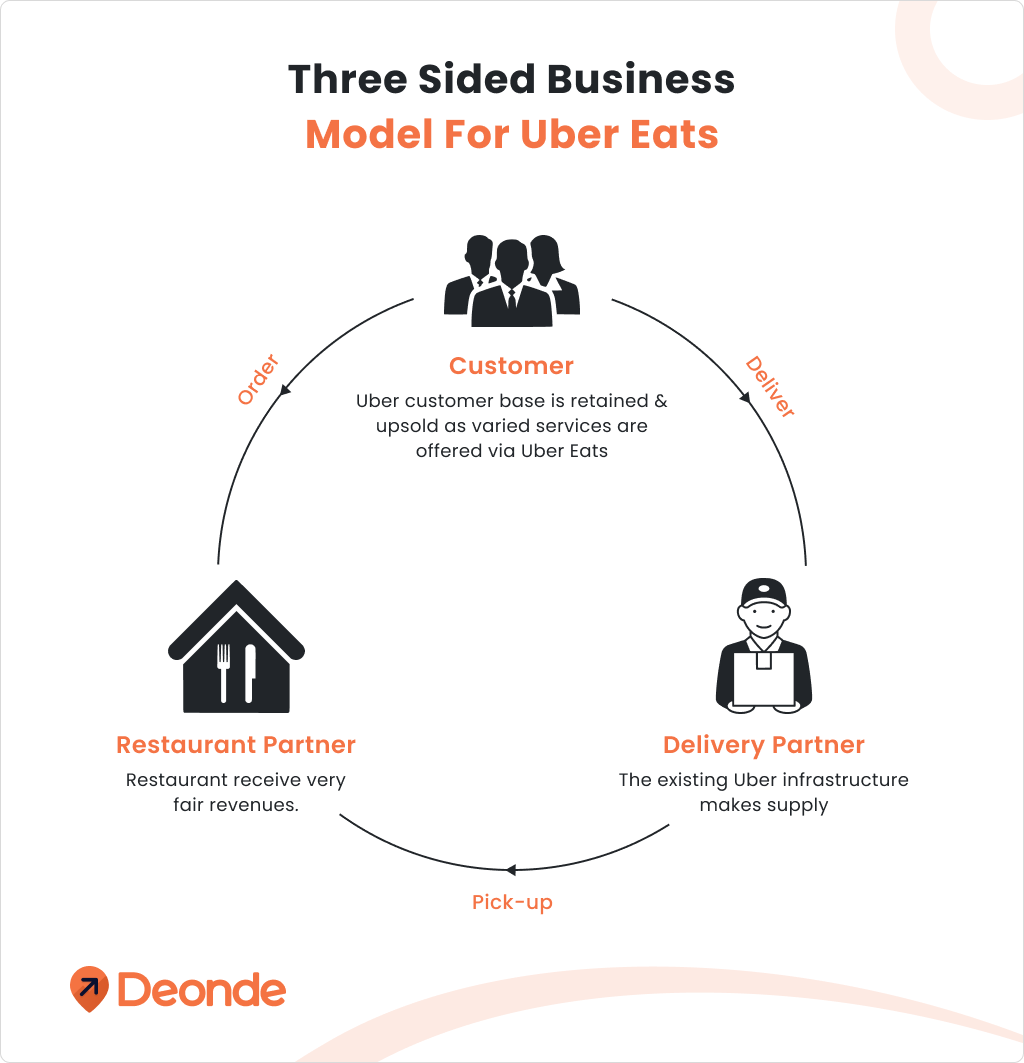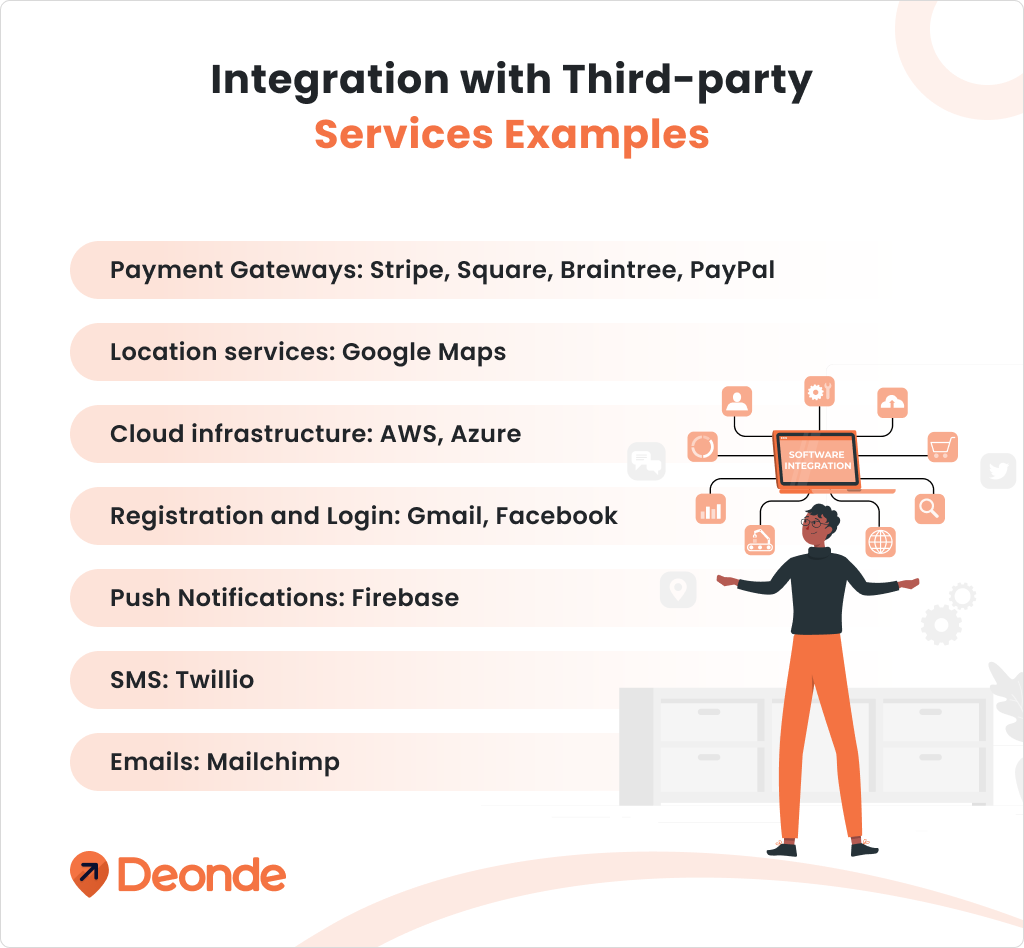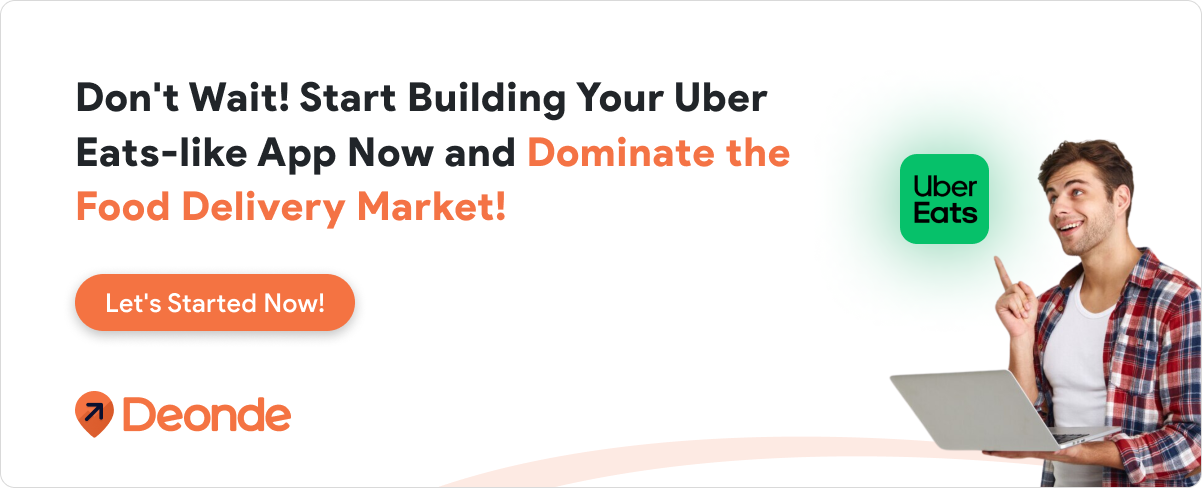Introduction
The online food delivery landscape is teeming with apps like Uber Eats, Grubhub, DoorDash, Zomato, and Swiggy.
As the industry grows, new players with advanced food delivery platforms emerge daily. Food startups and entrepreneurs worldwide are trying new ways to capitalize in this industry.
Hence, today, we’re writing to aspiring entrepreneurs who might need help creating an app like Uber Eats.
This blog will delve into the complexity of food delivery app development while understanding the features, costs, and resources needed to build an Uber Eats clone app.
Through this blog, we hope to equip Top Food Delivery Startups with industry insights and insider tips so they can confidently begin their entrepreneurial journey.
Keep reading on the Guide to Build An App Like Uber Eats.
What is Uber Eats?
Uber Eats is an American on-demand food delivery app headquartered in San Francisco. It facilitates transactions among app users, restaurants, and delivery partners.
Since its inception in 2014, Uber Eats has become extremely popular. It is actively trying to revolutionize how people get their takeouts.
Uber Eats has connected millions of app users to local eateries and restaurants as an aggregator software platform.
Uber Eats has taken the food delivery industry by storm in less than a decade.
With an estimated over 88 million users and 8,90,000 restaurants on its interface, Uber Eats has emerged as one of the most popular food ordering and delivery platforms.
In 2023, Uber Eats was the 2nd most downloaded food delivery app in the United States of America.

When Uber Eats was launched internationally in 2016-17, its annual revenue was about 0.6 Billion USD.
Since then, the company has scaled beyond imagination.
In 2023, Uber Eats generated revenue worth 3000 million USD in Q4 alone, averaging an annual revenue worth 12 billion USD! Uber Eats averaged an 11% year-on-year revenue growth—which is amazing for a food delivery app business.
From ordering to delivery: Understanding the Uber Eats workflow
These statistics were compelling enough to excite you about starting your own food delivery app.
But before that, let’s quickly go through Uber Eats’ process and workflow.
Ordering food online sounds simple enough on paper but is quite intricate.
The user downloads the app from the App Store OR Google Play Store. Alternatively, they can use Uber Eats’ web application on their browsers.
After registering, users can browse menus of restaurants available on the Uber Eats platform. Uber Eats tries to partner with various local restaurant vendors to cater to a large consumer base.
Once the users have selected what they want, they can add it to the cart. Before checkout, users can review and edit their selection.
They can also add promos and discount codes. Most first-time users get up to 50% off on Uber Eats. Uber Eats also rewards referrals with free meals or delivery discounts.
After the payment has been successfully processed, partner restaurants will be notified, and meal preparation will be initiated.
At the same time, Uber Eats notifies and asks an affiliated delivery driver to navigate to the restaurant for meal pickup.
As soon as the food is packed, the delivery partner drives it to the user.
Push notifications Templates help users receive all the updates, from food preparation to the delivery partner’s location and ETA.
Uber Eats also offers in-app messaging and telephone channels to bolster transparency so all involved parties stay connected.
Users can rate their overall experience with Uber Eats once the order is delivered.
Understanding the Uber Eats business model
In this section, we illuminate key aspects of the Uber Eats business model canvas and briefly state the prime Uber Eats stakeholders, activities, and value proposition.
We’ll also review the pressing question of how Uber Eats generates revenue.
Uber Eats’ Partners
Uber Eats uses an aggregator food delivery business model, listing restaurants and delivery drivers as its primary partners. Under this traditional model, Uber Eats enables users to place orders that restaurant vendors fulfil.
The company also depends on last-mile logistics for food delivery. Uber Eats uses the infrastructure of its ride-hailing app, Uber, to deliver orders.

While Uber Eats leverages its existing network of drivers, others (Grubhub, Zomato, DoorDash) may recruit their own drivers or work with a third-party logistics provider.
Key Uber Eats Activities
As an aggregator platform, Uber Eats must partner with local restaurant vendors. These vendors enter into a contract with Uber Eats. Once onboarded on the app, restaurants are listed on the Uber Eats interface.
Uber Eats empowers these restaurants with tools to prepare and deliver orders. The restaurant vendor app can manage menus, orders, inventory, and deliveries.
Uber Eats also needs to leverage its existing driver network. They connect drivers with restaurants to facilitate seamless delivery. Uber Eats has a driver interface for this. This interface allows drivers to navigate, track earrings, and communicate with restaurants.
The user app we’re all familiar with is developed to help users choose and order meals. Uber Eats is obliged to address consumer concerns and provide customer support.
Also Explore: Deliveroo vs Uber Eats
Uber Eats Value Proposition
Uber Eats aims to manage the process of online food ordering and delivery globally.
By conflating the physical world with technology, Uber Eats delivers restaurant-style meals to its users at the tap of a button.
With a prime focus on convenience and affordability, Uber Eats’s unique value proposition can be summed up as:
Uber Eats aims to provide fast, reliable food delivery services while maintaining the highest quality and safety standards.
With an intent to serve globally, Uber Eats partners with multiple restaurant vendors and serves a wide selection of hyper-local cuisine.
Uber Eats does all this while empowering its delivery fleet and restaurant vendors with fair and transparent processes.
Uber Eats Revenue Model
As a food delivery entrepreneur, you must be interested in finding out Uber Eats’ source of revenue. The truth is that Uber Eats has multiple lines of business. Hence, it’s worth taking a while to understand Uber Eats’ revenue model:
Revenue generated from Restaurant Vendors
Restaurants receive orders through the Uber Eats portal. In turn, Uber Eats takes a cut of restaurant earnings. Uber Eats charges restaurant vendors a commission fee that ranges from 30 to 35% of the total order value.
Uber Eats helps restaurant vendors gain more visibility by promoting them on the app. Have you seen banner ads on Uber Eats? That’s in-app marketing. Uber Eats generates a huge chunk of revenue by marketing restaurant partnerships.
Revenue generated from Uber Eats Users
Uber Eats levies a fixed-service fee and a dynamic delivery fee to its users. Delivery fees vary based on distance and delivery driver availability. Delivery surge charges may be applicable if you’re ordering during peak hours.
On the other hand, service fees are constant and can be up to 15% of the total order value.
Next, Uber Eats generates recurring revenue through subscriptions and loyalty programs. Users can subscribe to Uber Eats.
Premium subscription holders enjoy extra discounts and free deliveries. These month-on-month premium subscriptions provide a recurring source of income for the company—-while covertly building a loyal consumer base.
Unique features of Uber Eats
Uber Eats has attained popularity among food delivery apps because it does much more than simply order and deliver.
Let’s look at how Uber Eats has positioned itself as a top-tier food delivery aggregator platform in the industry:
- Uber Eats has a large network of restaurant and delivery partners, which allows the company to scale effortlessly.
- Due to streamlined workflows and the availability of resources, Uber Eats can offer its consumers very competitive prices.
- Uber Eats also enables its users to schedule orders. This means users can order and have their meals delivered at the time and place they choose.
- Uber Eats’ restaurant manager app includes a dashboard that allows restaurant vendors to review KPI at the click of a button.
- With social media integration, Uber Eats encourages users to share food photos, videos, or even reviews on social media platforms.
- Uber Eats also offers the option of priority ordering for customers who wish to receive their meals faster than usual.
- Uber Eats has multiple search filters that make it convenient for users to find their favourite meals.
Other than these unique features, here is a list of basic features that every food delivery app like Uber Eats must have:

Step-by-Step Guide to Build An App Like Uber Eats
Developing food delivery applications like Uber Eats is a long and hard process. The mobile app has to be interactive, easy to use, and include all functionalities.
Here is a detailed view of all the stages of the Uber Eats clone app development:

Step 1: Conduct Market Research
The first step in app development is identifying market needs and business opportunities. This involves an in-depth analysis of your target audience and competition. Create a clear and concise business plan for your app based on your research.
Step 2: Create a prototype
Once you have a clear concept for your Uber Eats clone app, the next step is to create wireframes and develop a basic UI. This involves drafting user flows, mockups, and templates.
Step 3: Front-end Development
The next step is to develop the app’s front end. This involves creating the app’s user interface and functionality using programming languages such as HTML, CSS, and JavaScript.
Step 4: Back-end Development
Once the front-end development is complete, the next step is to develop the app’s back end. App development software is often necessary for both front-end and backend development. This involves building a server-side infrastructure that supports the app’s functionality, data storage, and security.
Step 5: Integration with Third-party Services
You may need to integrate your Uber Eats clone with third-party services such as payment gateways, maps, or social media platforms. This involves connecting the app to these services using APIs (Application Programming Interfaces).
Here are a few examples:

Payment Gateways: Stripe, Square, Braintree, PayPal
Location services: Google Maps
Cloud infrastructure: AWS, Azure
Registration and Login: Gmail, Facebook
Push Notifications: Firebase
SMS: Twillio
Emails: Mailchimp
Step 6: Testing
Before launching your Uber Eats clone app, thoroughly testing it for functionality, usability, and security is important. This involves conducting a range of tests, including unit testing, integration testing, and user acceptance testing.
Step 7: Launch and Deployment
Once the app has been tested and approved, it will be ready for launch and Deployment. This involves publishing the app to app stores such as the Apple App Store or Google Play Store and making it available for download to users.
How to Build Food Delivery App: Essential Tools
The right technology stack is crucial when building an app like Uber Eats because it forms the foundation for providing a seamless user experience.
You might need different technologies depending on the business model of your food delivery startup.
We’ve listed a few technologies to build a food delivery app similar to Uber Eats:

Cost of Developing an Uber Eats Clone App
To help you streamline your processes, we’re addressing one of the most pressing questions that might be keeping you up at night:
How much will it cost to build a food delivery app like UberEats?
As seen above, building an online food order and delivery app like Uber Eats from scratch is a very complex task. You can hire freelance developers from sites like Upwork or Fiverr based on your budget. While these freelancers are affordable, it can be a hassle, as following up with such freelancers is challenging.
Plus, you’ll have no control over the app development process and might be unable to monitor your app’s progress. As a result, you may pay more for an app that needs to be better or delivered on time.
Another option is to hire in-house developers and build your tech team. When considering this option, note that developing an app like Uber Eats from scratch is intensive and may require heavy upfront investments. This option is feasible for a large organization but not so much for early startups or SMBs.
Depending on your location, it may cost you anywhere from $50,000 to $150,000. The entire process of developing an app like Uber Eats can take up to 10 to 12 weeks. However, the exact timeline and expenses will depend on a range of factors, like extra features, design complexity, and choice of platform.
However, if you’re eager to kick-start your food delivery app business, consider something more convenient—like a white-label solution. Such solutions are cost-effective and deployment-ready.
To launch your multi-vendor food delivery app quickly, it would help if you explored white-label food ordering and delivery applications. Such solutions are cost-effective and deployment-ready.
With the right white-label solution, your food ordering and delivery app could run in days.
With Deonde, building an Uber Eats clone has never been easier
Deonde offers white-label food delivery software that is completely customizable and can be launched within a few days.
Deonde’s food delivery suite is an affordable Uber Eats alternative—perfect for startups–and costs only $99 monthly!
Here’s why we think you’ll love Deonde:
- Deonde offers feature-rich food delivery software solutions so you can quickly launch your online food delivery business without developing an app from scratch.
- Deonde’s Uber Eats clone solution is customizable. You can choose and edit features, elements, styles, and layouts to your liking.
- Deonde’s Uber Eats Clone can be tailored to grow your business. We recommend starting with essential features and slowly expanding to manage costs.
- Deonde offers multiple homepage layouts from which you can choose!
- Deonde’s white-label food delivery app is also open to API integrations, and we support over 30+ payment gateways!
Conclusion
Building a food delivery app like Uber Eats requires thorough planning and research. You need to inspect a unique market demand and then try to use your Uber Eats clone to bridge the gap. A comprehensive understanding of existing Uber Eats features, capabilities and technology stack is also required.
However, this knowledge transfer process and finding a suitable food delivery app development company is complex. Building an Uber Eats Clone App from scratch can take months and may cost several thousand dollars.
But we’re showing you the easy way out—consider working with Deonde. Feel free to reach out if you’re unsure how the Deonde delivery app works or need more information on Deonde. We will be more than happy to help.
Frequently Asked Questions (FAQs)
- How can I build an Uber Eats clone app?
To make a food delivery app like Uber Eats, try to emulate Uber Eats features for users, restaurant vendors, and delivery driver apps.
Focus on improving the experience for all stakeholders. Leverage functionalities like real-time GPS tracking, interactive menus, effortless payments, and push notifications to enhance user experience. Use advanced technology for route optimization, order management, and delivery allocation to improve the app’s efficiency.
- Which apps are similar to Uber Eats?
Here is a list of apps similar to Uber Eats:
DoorDash, Grubhub, Postmates, Zomato, Swiggy, Deliveroo, Eat, Tapingo, Gopuff, and Food Panda.
- How much does it cost to create an app similar to Uber Eats?
The cost of developing a food delivery app like Uber Eats depends on several factors. It can cost anywhere between $10,000 and $150,000. The easiest way to build your Uber Eats Clone is to consider Deonde’s white-label SaaS food delivery solutions. They are readily customizable, easy to deploy, and start at $99/month.
- What are the advantages of using an Uber Eats Clone App?
Using the Uber Eats Clone app, businesses can reduce the time they spend on marketing. The app is pre-built and ready for Deployment. With slight customization, enterprises have a powerful app that can be successfully commercialized.





